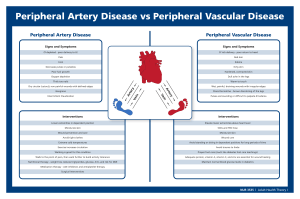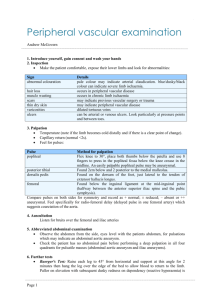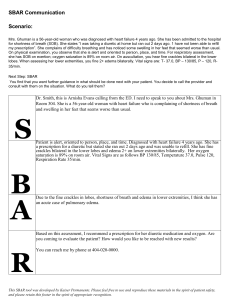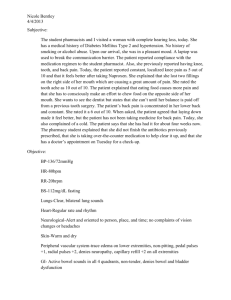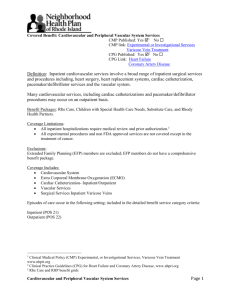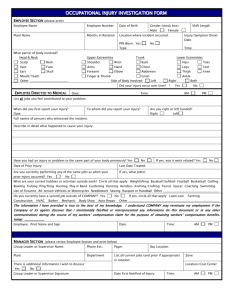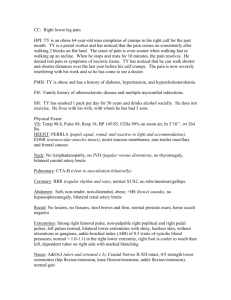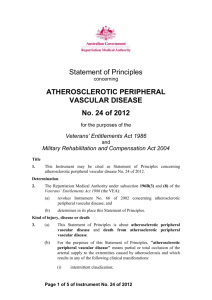Peripheral Vascular Assessment
advertisement
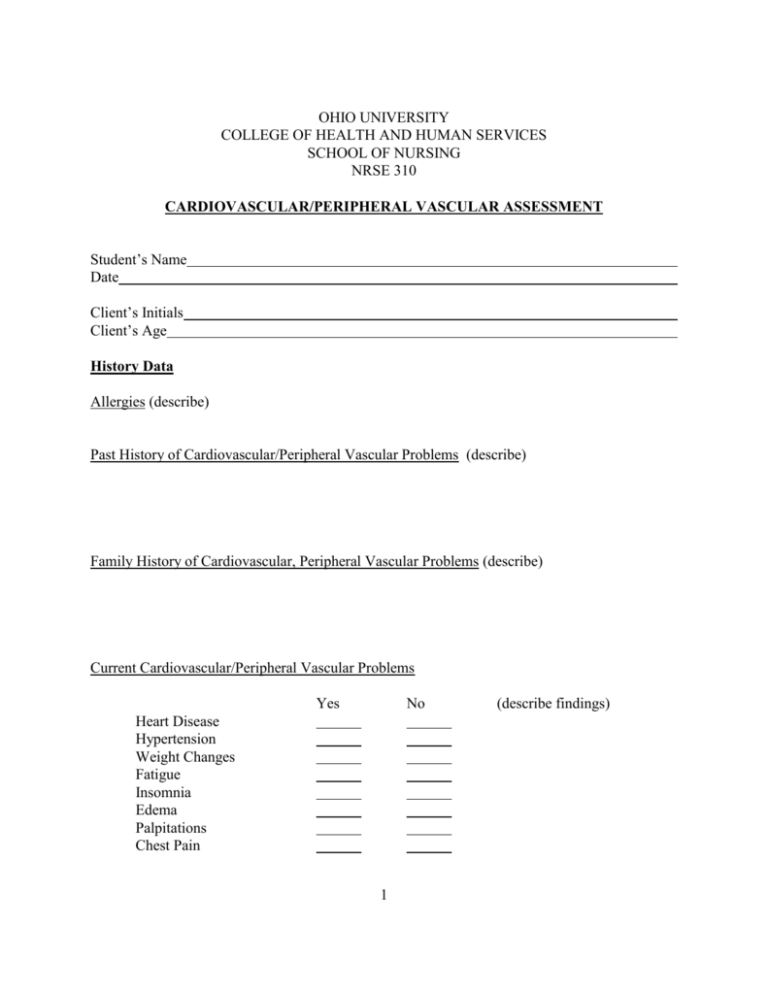
OHIO UNIVERSITY COLLEGE OF HEALTH AND HUMAN SERVICES SCHOOL OF NURSING NRSE 310 CARDIOVASCULAR/PERIPHERAL VASCULAR ASSESSMENT Student’s Name Date Client’s Initials Client’s Age History Data Allergies (describe) Past History of Cardiovascular/Peripheral Vascular Problems (describe) Family History of Cardiovascular, Peripheral Vascular Problems (describe) Current Cardiovascular/Peripheral Vascular Problems Yes No Heart Disease Hypertension Weight Changes Fatigue Insomnia Edema Palpitations Chest Pain 1 (describe findings) Pain in Extremities Typical Angina Pectoris Dyspnea on Exertion Orthopnea Cough Hemoptysis Epistaxis Nocturia Headaches Tinnitus Dizziness Night Sweats Gastrointestinal Symptoms, eg. Anorexia, Nausea, And/ or Bloating Paroxsysmal Nocturnal Dyspnea Hair Loss on Extremities Cold Extremities or Skin Temperature Changes Cyanosis or Other Skin Color Changes Increased or Decreased Sensitivity to Heat or Cold Syncope Near Syncope Murmurs Varicosities Thrombophlebitis Claudication Raynaud’s Phenomenon Rheumatic Fever Cerebrovascular Accident 2 Diabetes Mellitus Ascites Chorea Diphtheria Syphilis ** If the client answers in the affirmative, follow-up data such as where, when, character, duration, frequency, association, radiation, exacerbation, and relief of the problem should be noted. General Observations General Impressions Yes No Does client appear to be in distress? Does client look ill, in pain? Does client appear of normal body weight? Does client appear obese? Does client appear thin? Is client’s skin color normal? Does client have clubbing of the extremities? Does client have edema of the lower extremities? Does client have edema of the face? 3 (describe findings) Does client have edema of the body? Does client have neck vein distention? Physical Examination of the Cardiovascular System Ht Wt B/P B/P B/P (RA) (RA) (RA) (LA) [standing] (LA) [lying down] (LA) [sitting] Examine the cardiovascular system with the client sitting, lying, and lying in a left lateral recumbent position. In the actual examination, (i.e., inspection, palpation, and auscultation) systematically start from either the apical area and work upward to the base of the heart or vice versa. Instruct the client to relax and breathe regularly and normally during the entire assessment. Use both the bell and the diaphragm of the stethoscope to auscultate heart sounds. Percussion is deferred for this examination. Inspection Yes No (describe findings) Normal Abnormal (describe pulsations) Bulges or asymmetry of chest wall over precordium Visible pulsations on precordium Neck vein distention Scars over precordium Palpation Thrill Aortic Area Pulmonic Area Right Ventricular Area Epigastric Area 4 Auscultation Apical Pulse Rate Heart Rhythm Aortic Area Pulmonic Area Erb’s Point Tricuspid Area Mitral Area Normal ______ ______ ______ ______ ______ ______ ______ Abnormal ______ ______ ______ ______ ______ ______ ______ S–1 ______ ______ S–2 ______ ______ S - 3 Gallop (Ken-tuck-y) ______ ______ S - 4 Gallop (Ten-nes-see) ______ ______ ______ ______ ______ ______ ______ ______ ______ ______ ______ ______ ______ ______ (describe sounds) Extra Sounds: Clicks Friction Rubs Murmurs Carotid Bruits Jugular Venous Hum Femoral Bruits Peripheral Vascular Assessment – Inspection and Palpation Extremities Skin: Color Skin: Integrity Hair: Distribution Fingernails and Toenails: Shape Plate color Normal ______ ______ ______ Abnormal ______ ______ ______ ______ ______ ______ ______ 5 (describe findings) Texture Bed color Capillary Refill Mobility Clubbing Edema Atrophy Varicosities Peripheral Pulses ______ ______ ______ ______ ______ ______ ______ ______ ______ ______ ______ ______ ______ ______ ______ ______ [Note Rate and Rhythm] * BRACHIAL___RADIAL___FEMORAL___POPLITEAL___PEDIS___ TIBIALIS__ L : : : : : : : R : : : : : : : * 0 = absent, 1+ = weak, 2+ = normal, 3+ = strong, 4+ = bounding (How do these measurements compare with one year ago?) Neck Vessels Carotid Artery Jugular Vein Estimated Jugular Venous Pressure JVP = Normal ______ ______ Abnormal ______ ______ ______ ______ (describe findings) cms. Located at: http://www.ohiou.edu/nursing/CourseDocuments/310_5.doc Updated 9/01 6
